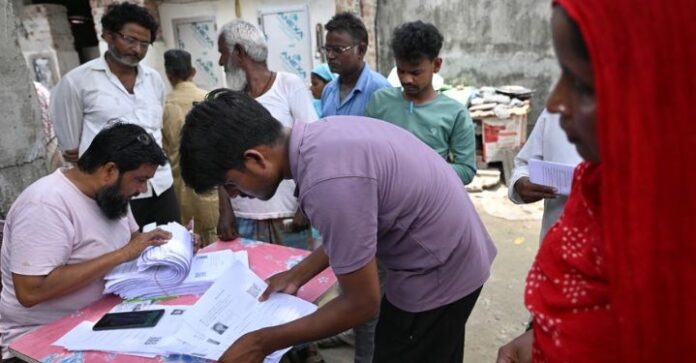Patna, July 11, 2025 – In what is being hailed as a landmark achievement in democratic participation, more than 74 percent of eligible voters in Bihar have submitted their enumeration forms as part of the Election Commission of India’s (ECI) Special Intensive Revision (SIR) of the electoral rolls. The massive response comes just 17 days into the drive, which is scheduled to conclude on July 25.
According to the latest update from the ECI, a total of 5.87 crore voters—out of 7.90 crore total electors in Bihar—have completed and submitted their forms. Officials say this high submission rate indicates increasing voter awareness and trust in the electoral process.
Driving Participation: Coordination at an Unprecedented Scale
The EC has deployed nearly 98,500 Booth-Level Officers (BLOs) across all 243 Assembly constituencies in Bihar. These BLOs are supported by an army of over 1.5 lakh political party agents, 4 lakh volunteers, and district-level election officials.
“This is one of the largest voter verification exercises ever undertaken in Bihar. The response is beyond encouraging—it is historic,” said a senior ECI official.
Each BLO has visited households with pre-printed forms, ensuring personal contact with every voter. They are instructed to make up to three visits per household to ensure every eligible voter gets an opportunity to participate.
Rapid Progress with Tech Integration
A key driver behind the speed and scale of this process is the BLO App, which allows officers to upload verified data—including live photographs and documents—instantly to the Election Commission’s central database.
By using digital platforms like ECINet, the commission has been able to minimize paperwork, detect duplication, and verify addresses far more efficiently. The combination of traditional door-to-door verification with mobile-enabled data entry has accelerated progress considerably.
As of July 10, over 57% of enumeration forms had already been collected. But in the following 24 hours, the rate spiked dramatically, with more than 83 lakh forms submitted—pushing the total beyond 74.39%, with two full weeks still remaining in the drive.
A People-Driven Electoral Reform
While much of the credit goes to BLOs, the ECI also points to the active involvement of political party agents, NGOs, and youth volunteers as critical success factors.
In particular, participation by college students, NSS and NCC cadets, and other community stakeholders has created a sense of urgency and civic duty at the grassroots level.
“The message was simple: your form equals your voice. And Bihar’s people have responded strongly,” said a district collector from Gaya.
Voters who had moved, changed their names, or recently turned 18 were especially encouraged to update their records. The pre-filled forms included existing voter details, which made corrections and verifications easier.
High Stakes: Why This Drive Matters
The Special Intensive Revision is taking place just months ahead of the 2025 Bihar Assembly Elections, and is intended to clean up and modernize the voter list. It was launched after concerns were raised about outdated entries, duplicate records, and missing voters.
By revising the rolls through house-to-house verification, the ECI hopes to:
- Eliminate fake or duplicate entries
- Ensure newly eligible voters are included
- Provide a corrected and transparent voter roll for the upcoming election
The final updated voter list is scheduled to be published on September 30, 2025.
Public Reception and Concerns
Though the campaign has generally been met with enthusiasm, some concerns have emerged regarding the documentation process—especially in rural and tribal areas.
In several parts of Seemanchal and northeast Bihar, voters have struggled to provide required documents like birth certificates, ration cards, or land records. While Aadhaar has been accepted in many urban areas as proof of identity, its acceptance has been inconsistent across districts.
“This inconsistency is worrying. In one district Aadhaar is enough, in another it is not. There should be standard guidelines,” said a local activist from Araria.
Legal Oversight: SC Steps In
The drive has also sparked legal challenges. A group of opposition parties recently filed a petition with the Supreme Court, alleging that the drive could lead to large-scale disenfranchisement—particularly of marginalized communities who may struggle to produce documentation or may be missed due to migration.
The Supreme Court is scheduled to hear the matter on July 10, and has sought clarity from the ECI on procedural safeguards to prevent wrongful exclusions.
In its defense, the Election Commission has stated that:
- No voter will be deleted from the roll without due process
- Every deletion will follow an inquiry and notice
- Appeals can be filed with the District Magistrate or the Chief Electoral Officer, under Section 24 of the RP Act, 1950
What Happens Next
Here’s the revised schedule for the entire process:
- June 24 – July 25: Form distribution and collection
- August 1: Publication of the Draft Electoral Roll
- August 2 – September 1: Period for filing objections and claims
- September 30: Final publication of the updated Electoral Roll
Officials remain confident that with the current pace, the form collection will surpass 90% by the final date.
Conclusion
The Special Intensive Revision of Bihar’s voter list has set a new benchmark for civic engagement in India. With more than three-fourths of the electorate having submitted their forms within just 17 days, the state has demonstrated the power of coordinated governance, technological integration, and community involvement.
Whether the process stands the test of judicial scrutiny remains to be seen. But one thing is clear: Bihar’s citizens are showing up—early, informed, and determined—to make their vote count.

